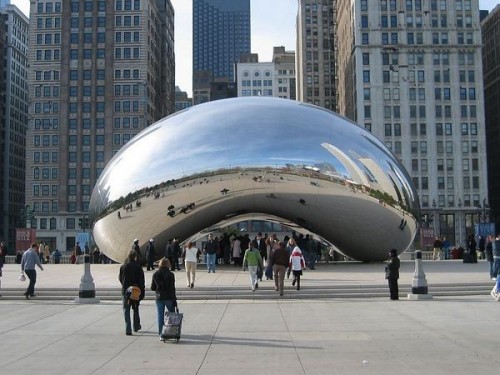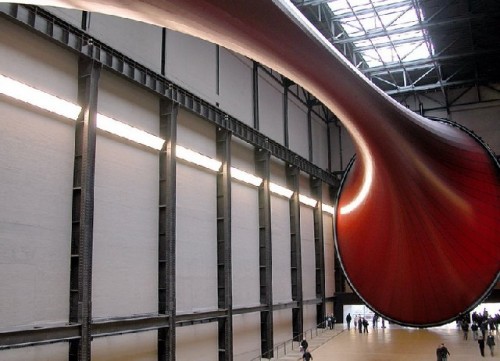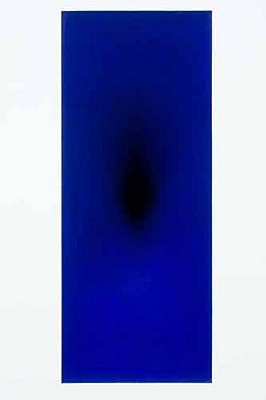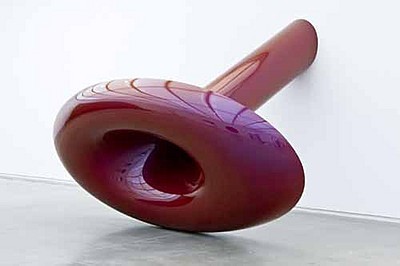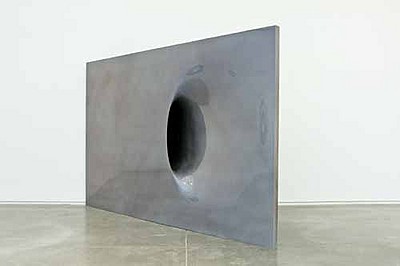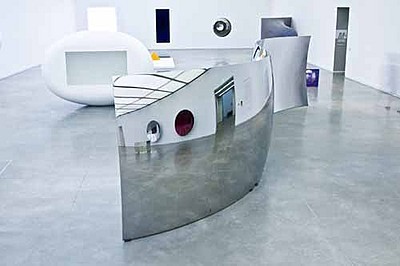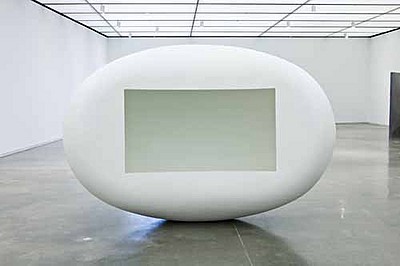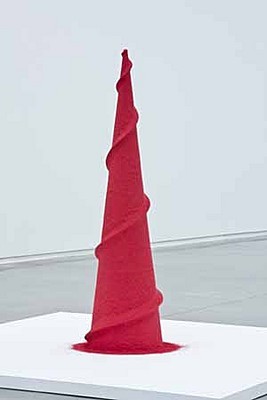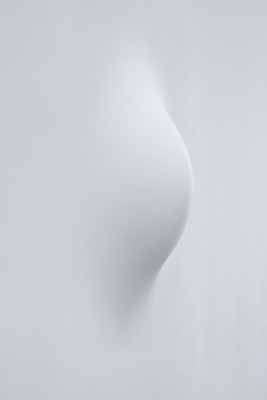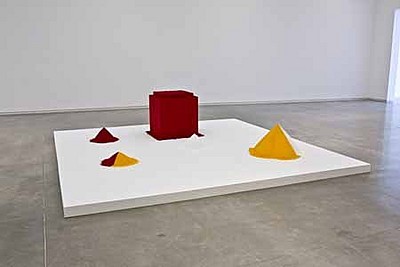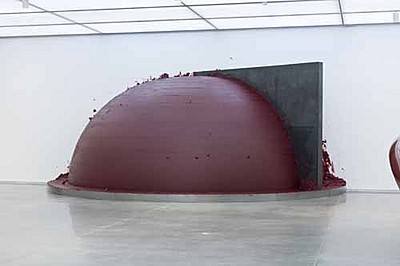Anish Kapoor: Past, Present, Future at ICA
World Class Sculpture Show Raises the Boston Bar
By: Mark Favermann - Jun 06, 2008
Through Sept. 7
At the Institute of Contemporary Art
Organized by ICA Chief Curator Nicholas Baume
100 Northern Avenue, Boston, MA
(617) 478-3100,
http://www.icaboston.org.
Now through most of the rest of the Summer, the Boston Institute Of Contemporary Art is exhibiting its best show since it opened in 2006 and perhaps the best exhibition of the early years of the 21st Century in New England. This is not exaggeration or hyperbole. Artist Anish Kapoor is the real deal.
Perhaps best known in the United States for his now iconic Cloud Gate, the 110-ton mirror polished stainless steel "bean shaped" piece for Chicago's Millennium Park, Anish Kapoor is now one of the preeminent sculptors in the world. His body of work inventively weds a modernist sense of pure materiality to a minimalist allure for manipulation of basic form in space. The Boston Institute of Contemporary Art is presenting the first major American museum show of his work in 15 years.
Turner Prize winning sculptor, Anish Kapoor was born in 1954 in Bombay, now called Mumbai, India. The son of an Indian Hindu father and Iraqi Jewish mother, he moved to England, in 1972, where he has lived ever since. He was a student at Hornsey College of Art and later at the Chelsea School of Art and Design. Kapoor emerged in the early 80's as one of a number of excitingly fresh sculptors working in new, individual styles and gaining a great deal of international recognition for their work. Though he works in London, he frequently visits India. Kapoor explains the inspiration for his work through both Western and Eastern cultural influences.
Kapoor is interested in the synthesizing of art, culture and perception. He is a bit of a slight of hand magician, a bit of a shaman showman and a bit of an energetic engineer. This could result in a slick but shallow visual presentation. There is a certain amount of this in his work. His special aesthetic and artistic ability, however, transcend all of these aspects.
Throughout this thoughtfully chosen ICA show, Kapoor continually demonstrates the ability to visually dazzle and to stimulate intellectual questioning. "Anish Kapoor: Past, Present and Future" is a survey of Kapoor's work from the last 15 years or so through 14 often brilliant works.
The pieces in the show demonstrate Kapoor's rich creative vein. He has many directions which flow out of each other or in opposition or contradiction to each other. This is heroic minimalism, even an aesthetic muscularity. Space, form and shape all are called upon by the artist to create his sculpture. In their simplicity, each of these sculptures are often quite complex. His mix of visual tools is at times a bit magical. There is often a visceral or at least an appealingly tactile surface to various pieces as well. Walls indent, create voids that form dark cavities that could become secret tunnels, while other walls protrude and bulge rather seamlessly in an almost expectant way.
His "Marsupial," 2006, is a recently created example of the former. Kapoor's deep blue "My Body Your Body," 1993, is an even subtler piece that underscores his elegant touch and talent. An example of the latter is "When I Am Pregnant" another fabulous piece he first created in 1992. This sculpture is an implied form, an architectural adjustment of surprise. All of the works in the exhibit have an essentially human scale. They are quite anthropomorphically appropriate. That is part of their elegant accessibility.
We encounter his mixed cultural traditions in these works as well. His use of color is certainly personal: often monochromatic or saturated specific pure colors. His pieces can also be highly polished, reflective like Millennium Park's "Cloud Gate" (aka The Bean because of its giant 12' high by 33 ' wide jelly bean shape ) or the s-curve shown at the ICA, a double, highly polished, steel curve. Here are mirrors of our environment and reflections of ourselves. Are these pieces part of our environment or do they only reflect it? Or, do they do both and therefore more? Perhaps, this is Anish Kapoor's point.
His Shamanesque "1000 Names," 1979-80, looks like an Eastern red icon. It has an architectural feel as well as the form of a ritualistic tool. Is this a spiraling altar or a model for a spiritualistic tower? The other "1000 Names," made up of various shapes and colors, also from 1979-80, expresses a sense of ritual interactivity. How Hindu or Kabbalah influenced it is certainly is up for conjecture, but the pieces speak to this sacred nature when the artist uses dry pigments and precise element placement.
Kapoor's work demonstrates a clear homage to Minimalism but also has a strong connection to the visceral nature of Josef Beuys' primal works. There is great artistic exploration of visual illusion in his use of different materials, abstraction, lightness, weightiness and simplicity of forms. Picasso once said, "Color is red." Kapoor seems to feel this as well. His use of red is nothing if not adoring. The red pieces in the show visually vibrate.
The elegantly crafted "Inwendig Volle Figur," 2006, is somewhat reminiscent of the huge installation piece that Kapoor created for the Tate Modern's Turbine Hall in 2002-2003 in London. "Marsyas" was comprised of three steel rings joined together by a single span of PVC membrane. Two were positioned vertically, at each end of the gigantic space, while a third was suspended parallel with the bridge. Seemingly wedged into place, the geometry generated by these three, rigid steel structures determined the sculpture's graceful form, a physical and visual shift from vertical to horizontal and back to vertical again.
Like its larger and earlier sculptural forbearer, this smaller piece has a suggestive and even provocative geometry. "Inwendig Volle Figur" has a deep red color that suggests something very physical even earthly or bodily. Here, like in many of his more heroic pieces, Kapoor tries to confound our spatial perception, immersing the viewer in a sculptural monochromatic field of color that is defined by a powerful but vaguely recognizable form.
One of the largest and perhaps most problematic pieces in the exhibition is arguably the piece that the exhibit is named for "Past, Present, Future," 2006. This is a huge half dome shaped piece of deep red wax and acrylic paint continually and slowly being kept in shape by a giant built-in scraper. It intersects a museum wall and appears to be some sort of giant art machine. Its slow hour long transformation and continuous slight reshaping is mysterious and somehow a little unnerving.
Anish Kapoor seems to have been influenced by many artists along with Beuys including Richard Serra, Donald Judd and John McCracken. Over the last 25 years or so, he has transformed these influences into an evolving personal aesthetic. There is a persistant beauty in all of his pieces. The survey of his work at the Boston Institute of Contemporary Art is a triumph for the artist and for its viewers. The ICA should be saluted. A world-class show in a world-class museum building. This great contemporary art show in Boston makes one think that Boston is visually and perceptually joining the 21st Century.

